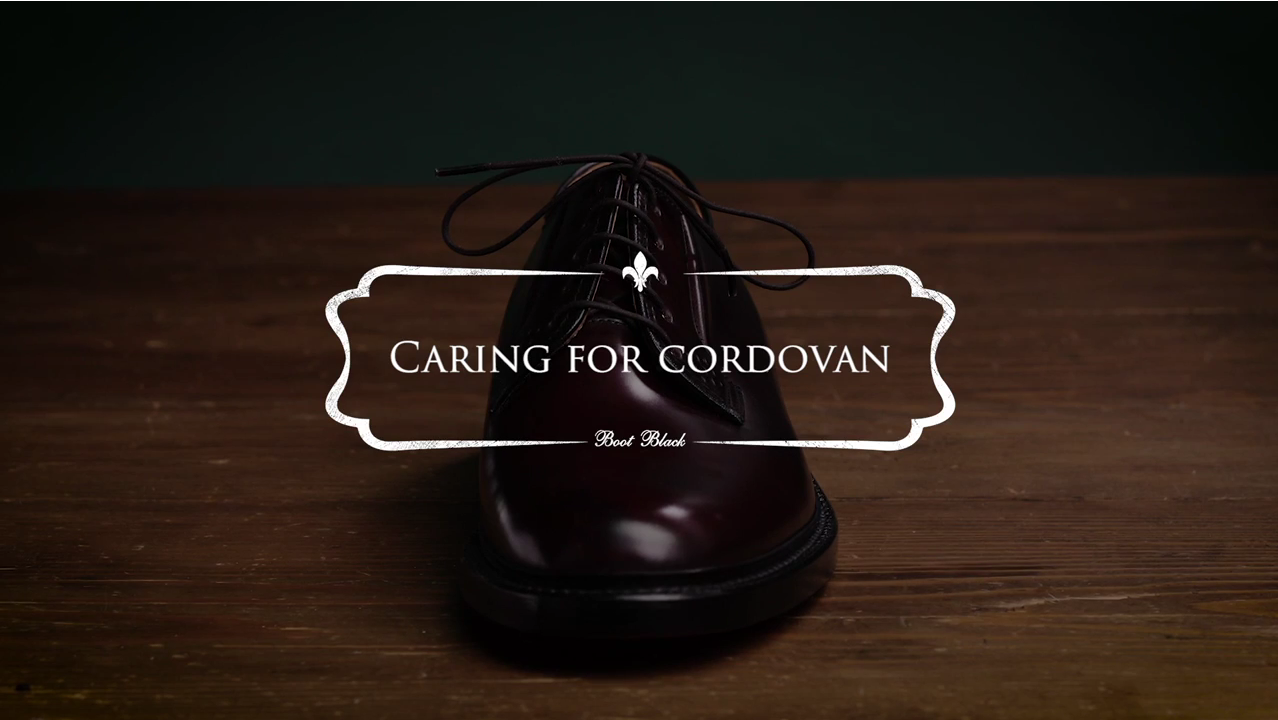
Shell Cordovan
Strictly speaking, Shell Cordovan is not a leather but the tanned flat muscle of the horse, which is fused with the skin and surrounded by fascia and this gives him together with the smearing and shine bumps the very special optics and attributes.
What you need
Shoe brush. short horsehair
large cotton cloth
leather cleaner
Shell Cordovan Cream
polishing brush
Time
10-15 minutes
The oval shells are polished after licking (greasing) and colouring by rubbing coloured oil, also called smearing, with a quartz roller.
The surface of the Shell Cordovan is formed by the fascia, the white-blue shimmering cell tissue in an untanned state, which in a living animal serves to supply the muscle with nutrients and lymph fluid.
This explains the formation of bubbles when walking through the rain with Shell Cordovan shoes:
The surface, the fascia, may take up the raindrop, but cannot (no longer) transport it, and on the other hand the nonsense, which is very common on the Internet, that you should rub your Shell Cordovan shoes completely with distilled water to “remove” the bubbles.
That’s complete nonsense!
Only the fascia surface would be evenly soaked with water, so that the entire leather surface would swell up.
Then, of course, you won’t see any individual water spots any more.
From the finishing of the Shell Cordovan with an oil-fat mixture, the licking, and the additional rubbing with coloured oil before the final shine,
it turns out that SC is actually a greasy leather and
can only absorb very, very little shoe polish.
This is why it often happens that the shell cordovan is saturated with the cream and lumps of cream or white lumps of fat settle on the surface.
These can be removed very easily with a good leather cleaner – but please apply very little pressure.
Shell Cordovan is extremely easy to care for – simply polish with a multi-folded cotton cloth in the old manner of the shoe shinists by pulling it back and forth.
After moulding and dusting with the shoe brush, take a large cotton cloth and fold it lengthwise so that you have a cloth of 40 cm, 50 cm length, which you grip with your hands at the ends and polish the shoe clamped between your thighs in a good old shoe polish manner.
Friction generates heat and with heat liquids expand!
The richly colored oil contained in Shell Cordovan heats up, expands and penetrates to the surface, where it provides the uniform and SC-typical shine.
Only if this measure is of no use
OR
Shell Cordovan is dirty, be it small wax spots, because too much shoe polish has been applied beforehand,
OR
be it other contaminations,
FIRST THEN the care continues with a leather cleaner.
The sole care of the shoes naturally remains unaffected.

step 2
Remove the shoelaces, insert the shoes and brush them off with a shoe brush.
Then clean the leather surface with a leather cleaner – the lotion with the black label, i.e. the normal one, is suitable here.
and rub the shoe shaft with it WITHOUT pressure.
If you want to clean the shoes as gently as possible or remove the grease that has escaped in the creases, then it is best to do this with a leather surface cleaner such as High-Shine Cleaner,
because it does not penetrate the leather, so it does not remove any oil or grease, but only acts on the surface and removes the grease very quickly.
If necessary, change the contact area if it is dirty and drip some lotion or High-shine Cleaner on it.



Then use a new area of the used cloth and really just add a hint of Cordovan Cream – less is more, and with Shell Cordovan almost nothing on the rag is the ideal amount!
Please remember – as mentioned before, Shell Cordovan is an oiled leather per se!
All you need is a hint of Cordovan Cream, which you should rub out completely – only when you see that nothing is left on the SC, only then do you take up almost nothing of the cream again.
– I deliberately avoid the expression LEATHER,
because it could lead to a mix-up with horse leather,
which, however, is tanned and prepared and maintained differently:
span style=”color: #0c71c3;”>Horse leather is a veritable leather – Shell Cordovan is Shell Cordovan
If you have now rubbed both shoes minimally with the Cordovan Cream in offset circles and it has dried:
STEP 4


Airing the wax layer on the Shell Cordovan,
please do the finger test first and polish the shoes with a long horsehair or bridle polishing brush.
Bridle are pig hair – softer than horsehair and harder than goat hair – ideal for polishing.
Unfortunately, pig hair, Bridle, is almost unknown in Europe,
and it is all too often confused with pigsbristles a wild boar.
To a high gloss – but WITHOUT losing the Shell Cordovan-typical shine – bring the shoes after half an hour or an hour – when the wax on the surface is completely cured with the multi-folded cotton cloth described above.
Please don’t forget!
You can also polish shoes up again – so you don’t have to put new cream on them every time you wear them – this would only lead to supersaturation:
The clotting would be the less pleasant consequence.
Applying a layer of wax to a Shell Cordovan shoe is an outrage:
Then the typical Shell Cordovan shine is lost and replaced by the wax shine – why pay so much money for Shell Cordovan?





